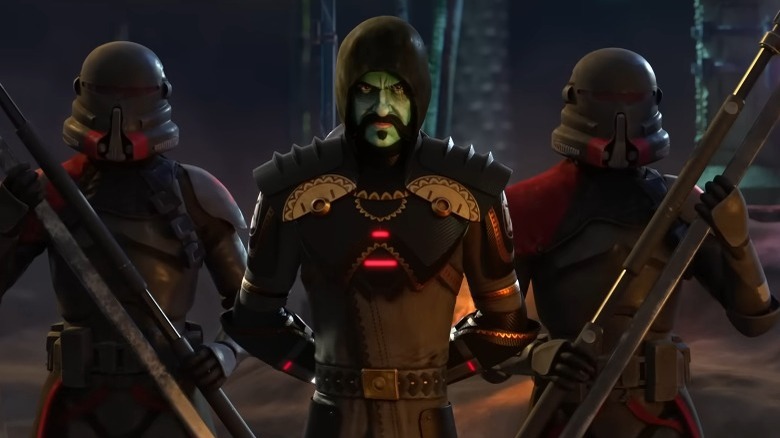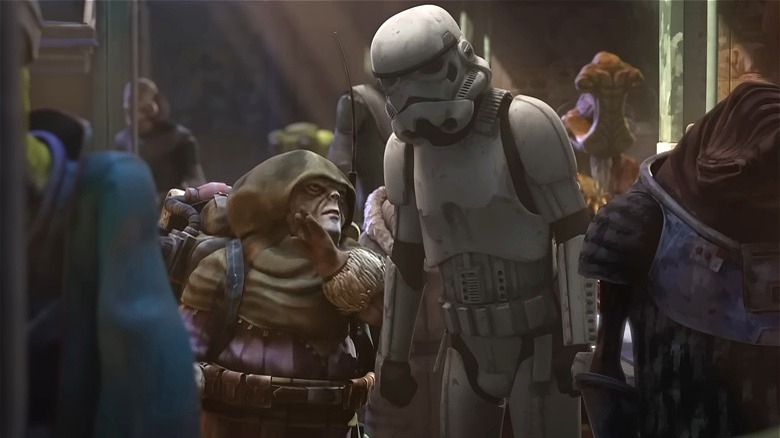One Star Wars: Visions Season 2 Episode Is A Bold And Brilliant Tribute To Bollywood Cinema
This post contains spoilers for Season 2, Episode 7 of "Star Wars: Visions," "The Bandits of Golak."
The latest season of "Star Wars: Visions" continues the tradition of telling diverse, poignant stories about the many, many pockets of rebellion scattered across the galaxy. Almost every story in season 2 contains the throughline of stepping into one's power, where a sense of personal purpose unlocks the path to challenging the Empire in small, yet meaningful ways. The biggest, boldest stories are the ones steeped in specific cultural traditions, wherein creators are able to weave their own cultural backgrounds into the DNA of "Visions," allowing fresh, interesting perspectives to emerge in a franchise with limitless possibilities.
One such story is Ishan Shukla's "The Bandits of Golak" from the Indian animation studio, 88 Pictures. "The Bandits of Golak" centers around Rani (voiced by Sonal Kaushal), a Force-sensitive kid who does not quite understand the true significance of her abilities as she and her brother are hounded by Imperial forces. While this might have played out as yet another tale about a gifted child who represents hope for the future of the galaxy, Shukla elevates the story by drawing from and subverting one of the most prominent tropes in '90s Bollywood cinema: The notorious bandit, or dacoit.
"The Bandits of Golak" does more than incorporate a once-viral subgenre of Bollywood movies — it pays homage to the very essence of Bollywood with the fluid emotionality inherent throughout the short, replete with stunning action sequences. There's genuine, heartfelt representation too, where a sari-wearing, lightsaber-wielding Rugal (Lilette Dubey) fights off a deadly Inquisitor, which is a sight we have never seen before. Let us dive deep into this gem of an episode now, shall we?
Identifying true evil
The bandit or dacoit has always been a staple antagonist figure in Bollywood, so much so that it precipitated a trend of endless dacoit movies between the late 1970s and the early 1990s, with remnants of the trope seeping into what came after. Many of these characters were based on real-life bandits, with the setting being the Bhind-Morena ravines of Chambal Valley, which was once the site for rampant banditry by several dacoit gangs.
Bollywood mostly portrayed dacoits as dreaded figures — they were powerful, aggressive men who terrorized village folk for a living while brandishing bullet belts, tilak-smeared foreheads, and a penchant for Machiavellian monologuing. One has to look no further than Gabbar Singh (Amjad Khan) in "Sholay," whose brand of menace is so sinister that mothers use his terrifying reputation to scare unruly children into obedience.
However, some portrayals of these feared outlaw figures call for nuance. Films like "Sherni" and "Bandit Queen" posit female dacoits as complex beings shaped by societal injustices and personal trauma, while fairly-recent offerings like "Sonchiriya" capture the authentic struggles of living as an outlaw in Chambal. "The Bandits of Golak" leans into this nuanced, fleshed-out understanding of dacoits: men who are pushed to extremes due to caste-based discrimination and feudalism are seen opposing the Empire, and it makes complete sense.
After Charuk (Suraj Sharma) draws fire from stormtroopers to protect Rani (who uses the Force in a crowded local train), a band of dacoits attacks the Imperial troops, inadvertently helping Charuk evade them. Although small on the scale of resistance, these acts of disruption are necessary to push the widening boundaries of rebellion in the galaxy. While the dacoits might be morally-grey outlaws, nothing eclipses the ruthless, fascistic evil of the Empire that colonizes, devours, and erases entire communities.
Something so personal about trains
Action sequences set inside a moving train are not quintessentially Bollywood by any means, but there is no dearth of Bollywood films that use trains to convey a multitude of emotions. Lovers are united or separated as the train leaves the platform, life-altering meet-cutes occur inside crowded compartments, and heists are set exclusively on trains to heighten the stakes. Sometimes, local trains or Indian Railways, in general, are used to offer insightful commentary into the socioeconomic vignettes that shape characters, such as Mira Nair's brilliant "Salaam Bombay!" where train tracks are sites for both wonder and pathos.
"The Bandits of Golak" begins with a local train journey where Rani and Charuk are hoping to reach a safe destination after their village is plundered by Imperials. Rani's sensitivity to the Force makes her a target for the Empire, but she is too young to grasp the implications of being found out. Charuk, ever-anxious and protective of his sister, is ready to fight stormtroopers and climb atop a moving train if it means keeping Rani safe, and this is exactly what he does. The conversation that the two have about the anxieties of heading toward a bleak, unknowable future highlights the dangers of the times, where kids like Rani are forced to abandon their homes and seek safe spaces that are hard to come by.
Moreover, the animation style of the short effectively captures the essence of rustic Indian culture while integrating it into the aesthetic fabric of "Star Wars." There's a clear love for the franchise, along with a love for Bollywood as a whole — the common tropes are more than aesthetic/structural flourishes, as they're a tribute to Indian cultural and artistic landmarks that have never been portrayed with such vigor and sincerity in "Star Wars" before.
More Indian Jedi
There aren't any Indian Jedi in "Star Wars" except Depa Billaba, a formidable Jedi Master who was trained by Mace Windu himself. Personally, this sliver of representation was incredibly important to me — she was the only character with proximation to Indian descent, and seeing her story unfold in such a badass way made me feel seen. Depa was briefly seen in "The Phantom Menace" and has been a part of "Star Wars Rebels" and "The Bad Batch" since then, and is known to have fought valiantly in many battles, including the Malathon IX mission and the Third Battle of Mygeeto.
Although an important part of canon, Depa is a Jedi Master who contributed directly to events and fought alongside countless Jedi until the end. Outside of Depa, there are no grounded, everyday Indian characters in the "Star Wars" universe, as we've seldom explored this specific cultural pocket, let alone in an animated anthology series that celebrates the diversified spirit of the franchise. "The Bandits of Golak" radically changes this: not only do we see an Indian Force-sensitive kid but also an elderly Jedi woman named Rugal, who has no established backstory or canonical importance to set her up.
Rugal exists as a reminder that people like her have always existed in the galaxy, silently offering safe spaces for Force-sensitive kids of her community and fighting off villainous Inquisitors if need be. Moreover, the fact that the major standoff is set inside a dhaba conveys a lot: an otherwise neutral public space is now a site of active resistance. Moreover, the climactic revelation that the future of the galaxy also depends on Indian kids like Rani is the kind of representation that is absolutely necessary, and "The Bandits of Golak" is a bold, brilliant step in this direction.



